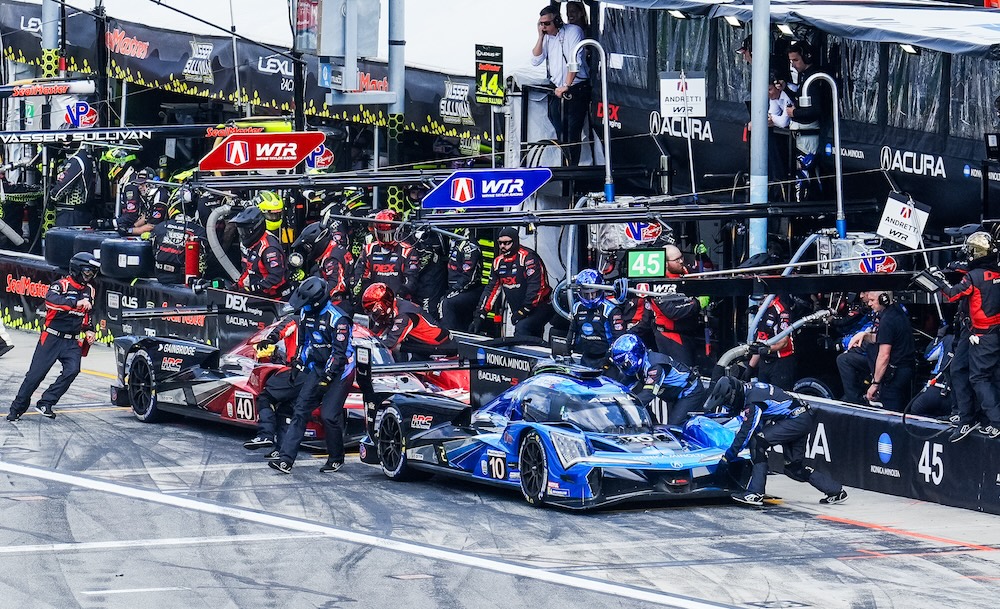If this were 2023 and Wayne Taylor Racing with Andretti only had a single car, the No. 10 Acura ARX-06, they’d be looking at a DNF at Daytona and a fifth-place finish at Sebring to show for their efforts. But it’s 2024, WTRAndretti is now a two-car team and the sole operator of Honda Racing Corporation’s GTP efforts in the IMSA WeatherTech SportsCar Championship, and with a victory in the Mobil 1 Twelve Hours of Sebring and a podium finish at Daytona, the team has a car tied for the championship lead.
The No. 10 team with core drivers Ricky Taylor and Filipe Albuquerque, with endurance addition Brendon Hartley and Marcus Ericsson on board for Daytona, has not had the best of luck so far this season, quitting in the night at Daytona and suffering a fluid leak at Sebring, and is currently eighth in the standings. Conversely, the new No. 40 with Jordan Taylor and Louis Delétraz, plus Colton Herta and Jenson Button, soldiered to a third-place finish at Daytona and won Sebring in style with a late-race push to the front.
[lawrence-auto-related count=3 category=1406]
“It’s a huge win for the team,” said Jordan Taylor after Sebring. “I think it’s their first win in the GTP class for Acura. First time as a two-car team as well. Our car, we stayed at a triple [stint] all day, didn’t have any big issues. The 10 car was extremely quick, drove to the lead at one point but had their little issue that they recovered from and recovered to a top five.”
Delétraz, Jordan Taylor and Herta are now tied for the championship lead with the Porsche Penske Motorsports No. 6 squad of Dane Cameron, Felipe Nasr and Matt Campbell after their 963 won Daytona with Josef Newgarden also on board. From that perspective alone, taking on the second ARX-06 previously run by Meyer Shank Racing has been a blessing.
“We are recognized now as a bigger team,” said team principal Wayne Taylor as the season began. “Ganassi and Penske have always been at that level — we haven’t. I think now is basically us starting from ground zero. But I can already tell, listening to the drivers and mechanics and engineers of all the different options we have on how we’re going to run … that’s the most important part. When you’ve got one, it’s always a risk. When you’ve got two, you’ve got two chances. That’s what we wanted, that’s what we’ve got, and now we have to execute.”

Albuquerque, of course, would like to have been spared the bad luck the team has experienced so far this season. Last year, he and Ricky Taylor were in the championship fight to the end, despite not visiting victory circle. But he recognized the value of having a second car from the beginning.
“It’s a big change, for sure,” he explained. “When you have options of trying things, you can spread them out. That’s the good thing having two cars — one car tries this, and the other one tries that to validate what we tested in the simulator. And when one car is faster than the other, sometimes we don’t know why, and then we get to learn about, ‘Oh, it’s this, causing a reaction to the car we were not expecting.’ All these things are important.”
In the second year of WTR’s union with Andretti’s motorsports empire, the benefits of the partnership are evident. As Wayne Taylor notes, it’s a short trip if they need some machining that requires tools they don’t have. And in 2025, all of Andretti Global’s North American teams will be under one roof in its new headquarters in Fishers, Ind.
WTRAndretti brought on one of Andretti’s IndyCar Series engineers in its expansion to more than 100 team members. It takes eight transporters to move the team’s three cars — the team added a Lamborghini Huracán GTD effort for Kyle Marcelli and Danny Formal as well in 2024 — its equipment and the massive pit stand. That pit stand houses 66 screens, 32 workstations, thee crew for the three cars, 12 drivers at Daytona, and some 40 Honda Racing Corporation personnel.
WTRAndretti is now fulfilling the vision that Wayne Taylor had for the team from its beginning, running two cars in a top factory program. And he’s happy that now that he no longer has to race another Acura team.
“We’ve got great drivers, a great crew, we have a great partnership with HRC and all our commercial partners,” he said. “Being the sole Acura team is really the best it could be — we don’t want to race against [other Acura teams], because when that happens, you start racing each other and forget about everybody else. Now, there’s a factory program that is focused on these two cars. All the resources of HRC, all our team, can focus on beating everybody else, and we’ve got nobody else to beat in an Acura.”





